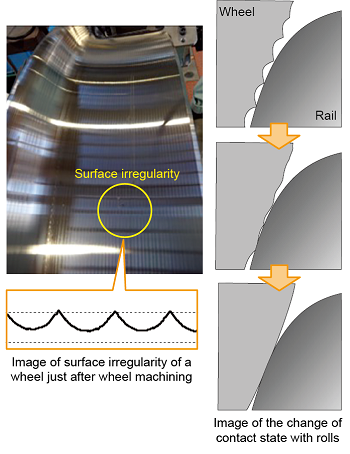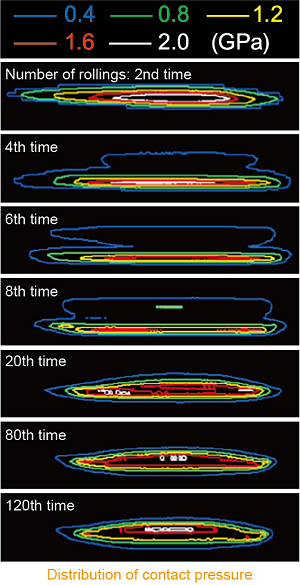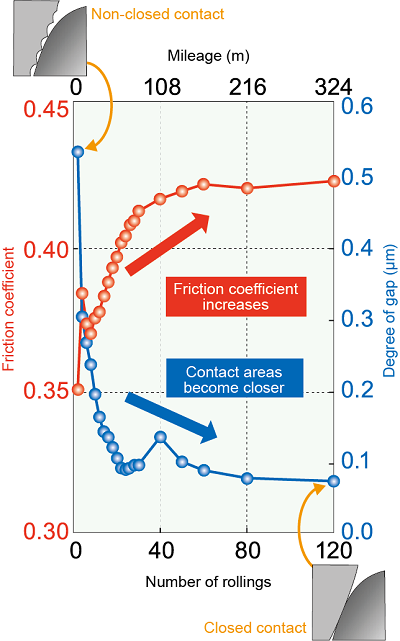24. Evaluation of the influence of wheel machining marks on the friction coefficient by visualizing the contact area
The higher the critical derailment coefficient is, the bigger the margin against vehicle derailment occurs. In order to obtain a high critical derailment coefficient, it is important to keep the friction coefficient between wheel flange and rail low. Since some derailments have occurred just after wheel machining, the friction coefficient between wheel and rail is considered to become higher immediately after wheel machining, but the influence of wheel machining on the friction coefficient has not been fully clarified. Therefore, we investigated the influence of wheel machining on the friction coefficient, by visualizing the contact area between wheel and rail just after wheel machining using ultrasonic waves (Fig. 1).
As a result of the friction test simulating sliding contact between the wheel flange and the rail just after wheel machining, we found that the friction coefficient increased with the increase in number of rollings. Therefore, we have developed a technique to visualize the contact area between wheel and rail in the process where the friction coefficient increases to check the changes in the contact state. As a result, the surface irregularities (wheel machining marks) were deformed by the 20th rolling, and the profile of the contact area tended to change rapidly (Fig. 2). Comparing the change in the friction coefficient with the degree of gap between the contact areas obtained by analyzing the visualization results, we found that the friction coefficient increased as the surface irregularities deformed and the contact areas became closer together (decreasing the degree of gap) (Fig. 3).
As the metal surfaces directly adhere to each other until some contaminants adhere to the wheel surface after wheel machining, the friction coefficient is expected to be kept high as shown in Fig. 3. Therefore, lubricating the wheel flange just after wheel machining is considered to be effective in reducing the friction coefficient.
Other Contents
- 22. Numerical simulation of ventilation in a vehicle by opening windows while running
- 23. Analytical evaluation method for the speed at which hunting occurs
- 24. Evaluation of the influence of wheel machining marks on the friction coefficient by visualizing the contact area
- 25. Wheel slide protection simulator to supplement on-track testing
- 26. Non-contact method to detect rail openings using aerial ultrasonic waves
- 27. Clarification of wear mechanism of current collecting materials caused by frictional heat
- 28. Method to evaluate physical properties of frictional materials by numerical simulation
- 29. Detection of changes in drivers' physical and mental state using physiological indicators
- 22. Numerical simulation of ventilation in a vehicle by opening windows while running
- 23. Analytical evaluation method for the speed at which hunting occurs
- 24. Evaluation of the influence of wheel machining marks on the friction coefficient by visualizing the contact area
- 25. Wheel slide protection simulator to supplement on-track testing
- 26. Non-contact method to detect rail openings using aerial ultrasonic waves
- 27. Clarification of wear mechanism of current collecting materials caused by frictional heat
- 28. Method to evaluate physical properties of frictional materials by numerical simulation
- 29. Detection of changes in drivers' physical and mental state using physiological indicators



